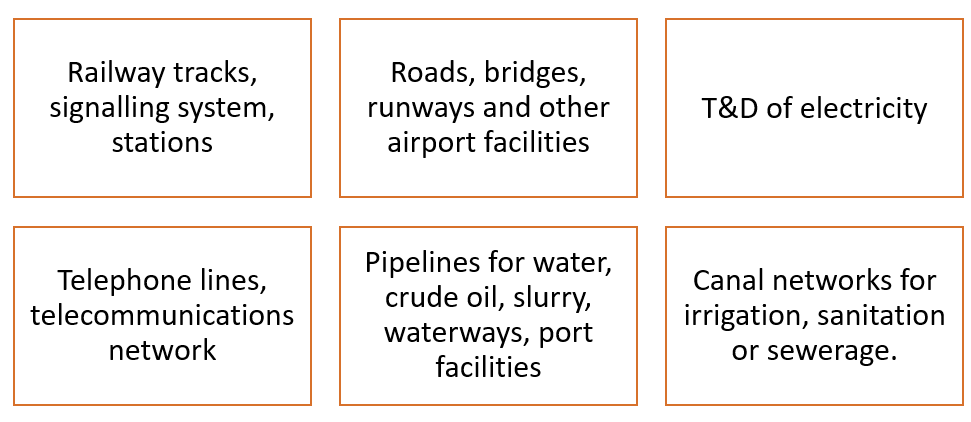वापस जायें / Back
Infrastructure Sector in India
Definition - Infrastructure is generally understood as the basic building blocks required for an economy to function efficiently.
The National Statistical Commission headed by Dr. C. Rangarajan, attempted to identify infrastructure based on some characteristics. The Rangarajan Commission indicated six characteristics of infrastructure sectors. These are: -
- Non-tradability of output (has to be sold at the location where it is produced)
- Non-rival-ness in consumption (The cost of providing a good or service to an additional individual is zero)
- High sunk costs (cost which is already incurred and cannot be recovered)
- Natural monopoly (high infrastructural costs and other barriers to entry relative to the size of the market give the largest supplier in an industry, often the first supplier in a market, an overwhelming advantage over potential competitors)
- Possibility of price exclusion (Price exclusion means that the enjoyment of benefits is contingent on payment of user charges)
- Bestowing externalities on society (externality is the cost or benefit that affects a party who did not choose to incur that cost or benefit.)

Based on these features, the Commission recommended inclusion of following in infrastructure in the first stage:

Rakesh Mohan Committee in “The India Infrastructure Report” included: telecom, water supply, gas, electricity, roads and industrial parks, urban infrastructure and railways, ports and airports in infrastructure.
Infrastructure is important for Growth and Development
Infrastructure Projects enjoy network externalities (positive spill over effects/benefits to other sectors/industries). The social rate of return is higher than the private rate of return in these projects, assuming that regulation does not allow network externality to be turned into a private rent. In other words, their impact of these Projects on GDP and its growth is high.
Infrastructure Sector in India
In 2016, India jumped 19 places in World Bank's Logistics Performance Index (LPI) 2016, to rank 35th amongst 160 countries. Foreign Direct Investment (FDI) received in Construction Development sector (townships, housing, built up infrastructure and construction development projects) from April 2000 to December 2017 stood at US' 24.67 billion, according to the Department of Industrial Policy and Promotion (DIPP). The logistics sector in India is expected to increase at a Compound Annual Growth Rate (CAGR) of 10.5 per cent, from US' 160 billion in 2017 to US' 215 billion by 2020. India has a requirement of investment worth Rs 50 trillion (US' 777.73 billion) in infrastructure by 2022 to have sustainable development in the country. India is witnessing significant interest from international investors in the infrastructure space. Some key investments in the sector are listed below.
- In February 2018, the Government of India signed a loan agreement worth US' 345 million with the New Development Bank (NDB) for the Rajasthan Water Sector Restructuring Project for desert areas.
- In January 2018, the National Investment and Infrastructure Fund (NIIF) partnered with UAE-based DP World to create a platform that will mobilize investments worth US' 3 billion into ports, terminals, transportation, and logistics businesses in India.
Announcements in Union Budget 2018-19:
- Massive push to the infrastructure sector by allocating Rs 5.97 lakh crore (US' 92.22 billion) for the sector.
- Railways received the highest ever budgetary allocation of Rs 1.48 trillion (US' 22.86 billion).
- Rs 16,000 crore (US'2.47 billion) towards Sahaj Bijli Har Ghar Yojana (Saubhagya) scheme. The scheme aims to achieve universal household electrification in the country.
- Rs 4,200 crore (US' 648.75 billion) to increase capacity of Green Energy Corridor Project along with other wind and solar power projects.
- Allocation of Rs 10,000 crore (US' 1.55 billion) to boost telecom infrastructure.
- The 90 smart cities shortlisted by the Government of India have proposed projects with investments of Rs 191,155 crore (US' 30.02 billion) which include Projects Focusing on Revamping an Identified Area (Area Based Projects) with investment of Rs 152,500 crore (US' 23.95 billion).
- The Government of India is working to ensure a good living habitat for the poor in the country and has launched new flagship urban missions like the Pradhan Mantri Awas Yojana (Urban), Atal Mission for Rejuvenation and Urban Transformation (AMRUT), and Swachh Bharat Mission (Urban) under the urban habitat model, according to Mr Hardeep Singh Puri, Minister of State (Independent Charge) for Housing
Other big Projects
India’s national highway network is expected to cover 50,000 Kilo Meters by 2019, with around 20,000 km of works scheduled for completion in the next couple of years, according to the Ministry of Road Transport and Highways.
The Government of India is devising a plan to provide wifi facility to 550,000 villages by March 2019 for an estimated cost of Rs 3,700 crore (US' 577.88 million), as per the Department of Telecommunications, Government of India.
India and Japan have joined hands for infrastructure development in India's north-eastern states and are also setting up an India-Japan Coordination Forum for Development of North East to undertake strategic infrastructure projects in the northeast.
Private Participation in Infrastructure Sector
Traditionally infrastructure development has been in the Public Sector in India because of low profit margins and high gestation period. However in recently Private sector has come in a big way in this sector. There are instances of fully private enterprises in infrastructure e.g. in telecom. However more often Public Private Partnership (PPP) models are followed for example in road projects, airports etc. PPP models have been of various types like BOT, BOO etc. They have also been based on partial budgetary support, annuity schemes and Special Purpose Vehicles (SPVs) with public sector organizations. Government has created special organizations for funding infrastructure Projects, like IIFCL, IFCI, HUDCO etc.